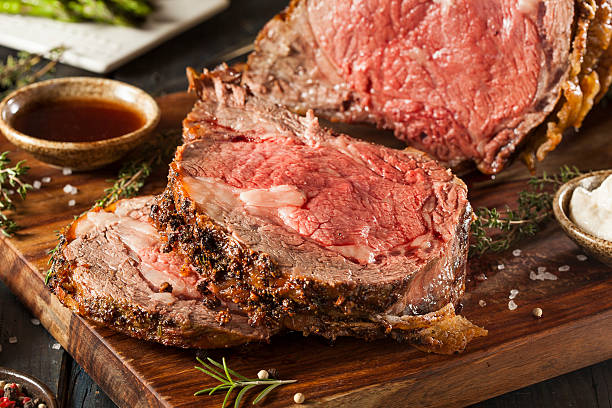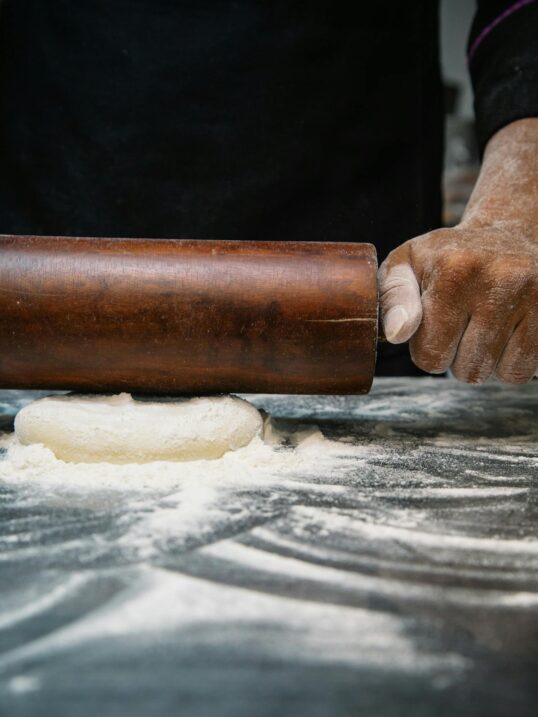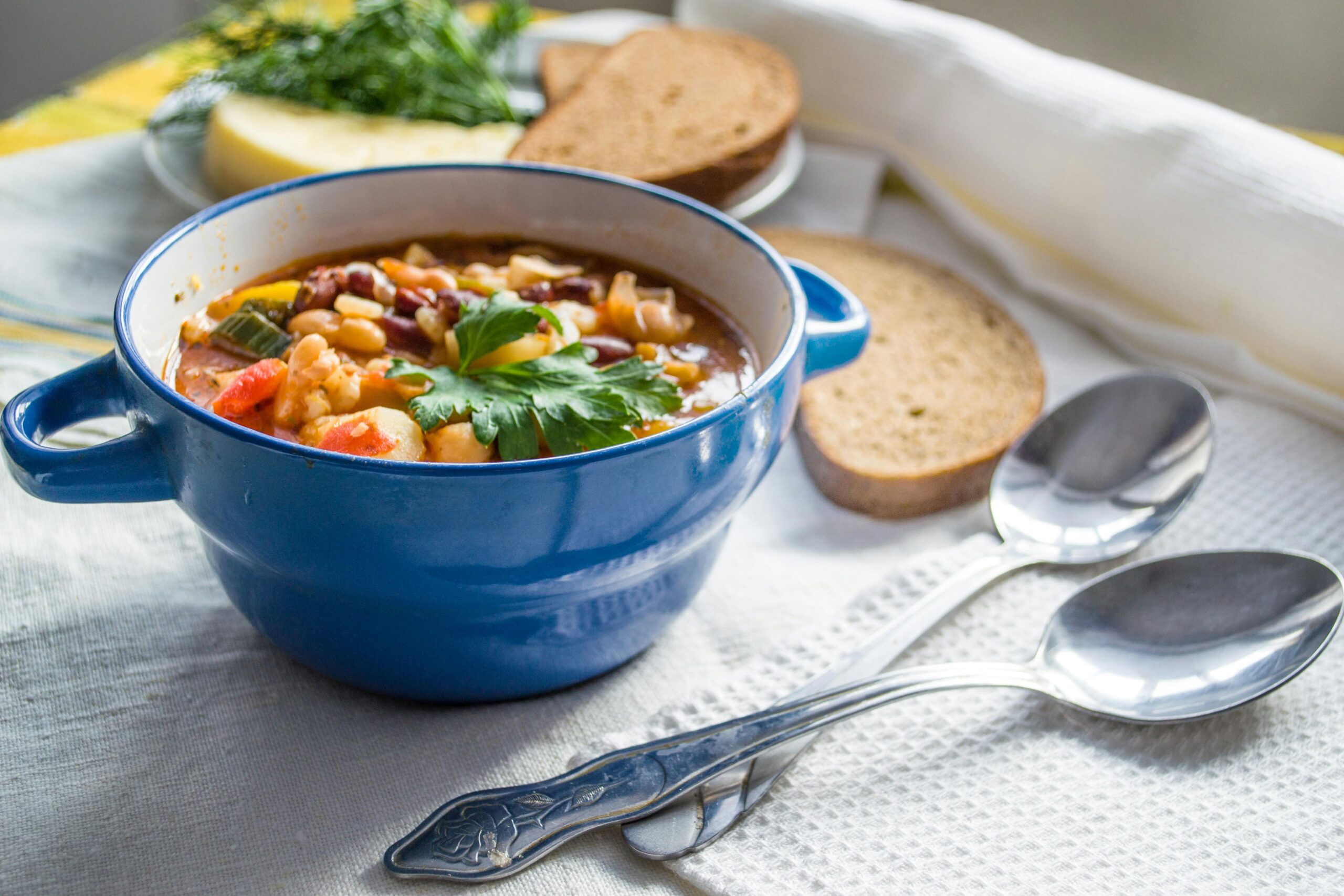When choosing the perfect cut of beef for a special occasion or family dinner, you might decide between prime rib and rib roast.
While these terms are sometimes used interchangeably, they’re not the same. Understanding the differences and similarities can help you select the right cut for your needs and ensure you cook it to perfection. Let’s dive into the key distinctions and similarities between prime rib and rib roast.
What is Prime Rib?
Prime rib, also known as a standing rib roast, is a popular cut from the cow’s primal rib section. This cut typically includes 6 to 12 ribs and is known for its rich marbling, tenderness, and robust flavor. It is often roasted bone-in, which adds extra flavor and helps retain moisture during cooking.
Prime rib is characterized by its high level of intramuscular fat, also known as marbling. This marbling melts during the cooking process, making the meat incredibly juicy and flavorful. It is traditionally roasted as a whole piece and served in thick slices, making it a centerpiece dish for holidays or special occasions.
Another distinguishing feature of prime rib is its presentation. With its bone-in structure, it has a dramatic and elegant appearance, which is why it’s often chosen for celebrations.
Prime Rib Recipes
- Roasted and Reverse Seared Prime Rib – Serious Eats
- Prime Rib Roast – NYT Cooking
- Perfect Prime Rib – The Kitchn
What is Rib Roast?
Rib roast refers to a broader category of cuts that also come from the rib section of the cow. Unlike prime rib, a rib roast can be sold boneless or bone-in and isn’t always tied to a specific cooking method. Rib roasts are versatile and can be seasoned and prepared in various ways, such as roasting, grilling, or even slow cooking.
Rib roasts can vary in quality depending on the grade, such as USDA Prime, Choice, or Select. This variation affects the marbling and overall flavor of the meat. A rib roast is suitable for a wide range of dishes beyond traditional roasting, offering flexibility for different recipes and occasions. Whether you’re slow-cooking a pot roast or grilling steaks, the rib roast can adapt to your culinary needs.
Rib Roast Recipes
- Low-and-Slow Rib Roast – Bon Appetit
- Boneless Rib Roast with Garlic and Herbs – Rachel Ray
- Sunday Rib Roast – Ina Garten
Similarities Between Prime Rib and Rib Roast
While prime rib and rib roast have many differences, there are similarities between the two.
Same Primal Cut
Both prime rib and rib roast originate from the primal rib section of the cow, located between the chuck and loin. This shared origin gives them comparable flavor profiles and tenderness, making either cut a reliable choice for a high-quality beef dish.
Rich Marbling
Both cuts are prized for their marbling, the intramuscular fat that melts during cooking. This feature contributes to the juicy, tender texture and robust flavor that make these cuts so popular for special occasions.
Versatility in Cooking
Although prime rib is traditionally roasted whole, both cuts can be cooked using various methods. Whether you prefer roasting, grilling, or slow cooking, these cuts can be adapted to different recipes and techniques to suit your needs.
Ideal for Celebratory Meals
Prime rib and rib roast both shine as centerpiece dishes for holidays, dinner parties, or other celebratory meals. Their tenderness and rich flavors can elevate any dining experience, making them popular choices for festive occasions.
Grading Options
Both cuts are available in different USDA grades, such as Prime, Choice, and Select. Higher-grade cuts have more marbling and tenderness, ensuring a luxurious eating experience. Choosing a USDA Prime grade guarantees superior quality, although lower grades can still deliver excellent results if prepared well.
Differences Between Prime Rib and Rib Roast
Understanding the differences between prime rib and rib roast will help you know when to use each cut of meat:
Bone-In vs Boneless
Prime rib is almost always served bone-in, with the ribs left intact to enhance flavor and retain moisture during roasting. This feature also contributes to its dramatic presentation. Rib roasts, on the other hand, are available both bone-in and boneless. The boneless version is easier to carve and cook, making it more practical for some recipes and occasions.
Cooking Tradition vs Flexibility
Prime rib is traditionally roasted whole as a centerpiece dish, emphasizing its luxurious marbling and rich flavor. Rib roast, however, offers more flexibility in preparation methods. Whether you want to slow-cook it in a crockpot, grill it for a smoky finish, or roast it with a spice rub, rib roast adapts to a variety of cooking styles.
Marbling and Quality
Prime rib is closely associated with higher-grade beef cuts, such as USDA Prime, which boast superior marbling and tenderness. While rib roasts are also available in higher grades, they are often marketed at a broader range of quality levels, including USDA Choice and Select, making them accessible for different budgets.
Price Difference
Prime rib tends to be more expensive than rib roast due to its higher marbling, specific preparation style, and association with celebratory meals. Rib roasts, particularly boneless ones or those of lower grades, are more budget-friendly and accessible while still offering excellent flavor and tenderness.
Presentation and Appeal
The bone-in structure and dramatic appearance of prime rib make it a show-stopping dish for formal occasions. Rib roast, while still impressive, is often chosen for its practicality and versatility rather than its presentation.
How to Choose Between Prime Rib vs Rib Roast
If you’re still not sure which meat to choose, here are other factors to consider:
Occasion
Consider the type of event or meal you’re planning. Prime rib is ideal for celebrations and formal dinners due to its impressive appearance and rich flavor. Rib roast may be better suited for everyday meals or recipes that require different cooking techniques.
Budget
If you’re looking for a cost-effective option, rib roast may be the better choice. Opting for a boneless rib roast or a lower grade can help you save money without compromising too much on flavor.
Cooking Method
Prime rib shines when roasted as a whole, bone-in cut, making it a showstopper at the dinner table. A rib roast offers more flexibility if you’re planning to experiment with grilling, slow cooking, or other methods.
Tips for Cooking Prime Rib and Rib Roast
These tips will help your prime rib or rib roast come out tasty and tender:
Seasoning
Generously season both cuts with salt, pepper, and your favorite herbs. A garlic and rosemary rub works beautifully for prime rib, adding depth to its already rich flavor profile.
Temperature
Use a meat thermometer to ensure perfect doneness. For rare, aim for an internal temperature of 120°F; for medium-rare, 130°F; and for medium, 140°F. Cooking to the right temperature ensures a tender and juicy result.
Resting
Allow the meat to rest for at least 15 minutes after cooking. This step lets the juices redistribute throughout the meat, enhancing its tenderness and flavor.
Slicing
Always slice against the grain of the meat. This technique breaks down the muscle fibers, making each bite more tender and enjoyable.
Insider’s Insight
Both prime rib and rib roast are excellent choices for beef lovers, offering rich flavor and tenderness. By understanding their differences and similarities, you can choose the right cut for your meal and prepare it to perfection. Whether you’re hosting a grand dinner or making a comforting family meal, these cuts are sure to impress.
FAQs: Prime Rib vs Rib Roast
Can I use rib roast instead of prime rib in recipes?
Yes, rib roast can often be used as a substitute for prime rib, especially if it is a bone-in cut. Keep in mind that the flavor and presentation may differ slightly depending on the preparation method and marbling.
What does USDA Prime mean?
USDA Prime is the highest grade of beef, known for its abundant marbling, tenderness, and flavor. It is often more expensive and used for cuts like prime rib, making it a popular choice for special occasions.
Is prime rib always bone-in?
Yes, prime rib is typically served bone-in, as the bones add flavor and help retain moisture during cooking. However, some butchers may offer boneless options labeled as prime rib.
Which is better for grilling: prime rib or rib roast?
Rib roast, particularly the boneless variety, is better suited for grilling due to its versatility. Prime rib is traditionally roasted whole, making it less ideal for grilling.
How do I store leftover prime rib or rib roast?
Leftovers can be stored in an airtight container in the refrigerator for up to 3-4 days. To reheat, wrap the meat in foil and warm it in the oven at a low temperature to maintain its tenderness.




Leave a Reply